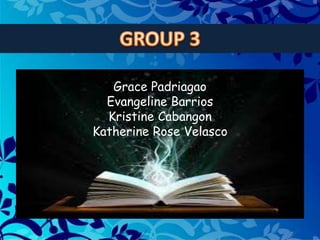
BIO GEO CHEMICAL CYCLE
- 1. Grace Padriagao Evangeline Barrios Kristine Cabangon Katherine Rose Velasco
- 6. The sun, which drives the water cycle, heats water in the oceans. Some of it evaporates as vapor into the air; a relatively smaller amount of moisture is added as ice and snow sublimate directly from the solid state into vapor. Rising air currents take the vapor up into the atmosphere, along with water from evapotranspiration, which is water transpired from plants and evaporated from the soil. The vapor rises into the air where cooler temperatures cause it to condense into clouds.
- 7. Air currents move clouds around the globe, and cloud particles collide, grow, and fall out of the sky as precipitation. Some precipitation falls as snow and can accumulate as ice caps and glaciers, which can store frozen water for thousands of years.
- 10. We usually refer to the cycling of carbon and oxygen in our atmosphere together because of how they are extremely interconnected. With the exception of certain bacteria all animals, including aquatic, animals need oxygen to survive. Even though our bodies are 80% water, Carbon is the most abundant element our bodies. It is carbon that combines to produce sugars necessary for energy. A cycle is a constant chain of events; there is no beginning and no end. A Process is a series of steps involves in creating something.
- 11. The Carbon/Oxygen Cycle involves three major processes and one minor process: photosynthesis, respiration, combustion and decomposition. Photosynthesis: Green plants/trees take in Carbon Dioxide and water using the chlorophyll in their leaves and energy from the sun they release Oxygen, sugar and water vapor.
- 12. Respiration: Animals take in simple sugars and oxygen and release carbon dioxide, water and energy Combustion: This is the process of burning. When combustion occurs CO2 is released into the atmosphere. Natural combustion includes volcanic eruptions, however most pollution problems occur because cars and factories release CO2 by their burning fossil fuels.
- 13. Decomposition: Is a minor part of the Carbon/Oxygen cycle Decomposition is when any organic matter (plants, animals) breaks down chemically into all the simple elements that they are made of and these elements return back to the environment. For example: When an animal dies all the carbon, oxygen, nitrogen, water, calcium etc. return to the soil and air during decomposition. Certain bacteria aid in the decomposition process. (Decomposers).
- 16. Organisms require nitrogen to produce amino acids. Nitrogen makes up seventy-eight percent of the atmosphere, but most organisms can not use this form of nitrogen, and must have the fixed form. The nitrogen cycle produces the fixed form of nitrogen these organisms need.
- 17. Step 1: A special type of bacteria called nitrogen fixing bacteria take in atmospheric nitrogen and produce ammonia (NH3). Step 2: Other bacteria use this ammonia to produce nitrates and nitrites, which are nitrogen and oxygen containing compounds. .
- 18. Step 3: The nitrates and nitrites are used by plants to make amino acids which are then used to make plant proteins. Step 4: Plants are consumed by other organisms which use the plant amino acids to make their own.
- 19. Step 5: Decomposers convert the nitrogen found in other organisms into ammonia and return it to the soil. A few of these type of bacteria return nitrogen to the atmosphere by a process called denitrification, however this amount is small.
- 22. Phosphorus is an essential nutrient for plants and animals in the form of ions PO4 3- and HPO4 2-. It is a part of DNA- molecules, of molecules that store energy (ATP and ADP) and of fats of cell membranes. Phosphorus is also a building block of certain parts of the human and animal body, such as the bones and teeth.
- 23. Phosphorus can be found on earth in water, soil and sediments. Unlike the compounds of other matter cycles phosphorus cannot be found in air in the gaseous state. This is because phosphorus is usually liquid at normal temperatures and pressures. It is mainly cycling through water, soil and sediments. In the atmosphere phosphorus can mainly be found as very small dust particles. Phosphorus moves slowly from deposits on land and in sediments, to living organisms, and than much more slowly back into the soil and water sediment. The phosphorus cycle is the slowest one of the matter cycles that are described here.
- 24. Phosphorus is most commonly found in rock formations and ocean sediments as phosphate salts. Phosphate salts that are released from rocks through weathering usually dissolve in soil water and will be absorbed by plants. Because the quantities of phosphorus in soil are generally small, it is often the limiting factor for plant growth. That is why humans often apply phosphate fertilizers on farmland. Phosphates are also limiting factors for plant-growth in marine ecosystems, because they are not very water-soluble. Animals absorb phosphates by eating plants or plant-eating animals.
- 25. Phosphorus cycles through plants and animals much faster than it does through rocks and sediments. When animals and plants die, phosphates will return to the soils or oceans again during decay. After that, phosphorus will end up in sediments or rock formations again, remaining there for millions of years. Eventually, phosphorus is released again through weathering and the cycle starts over.
- 28. Prepared by: Grace Padriagao